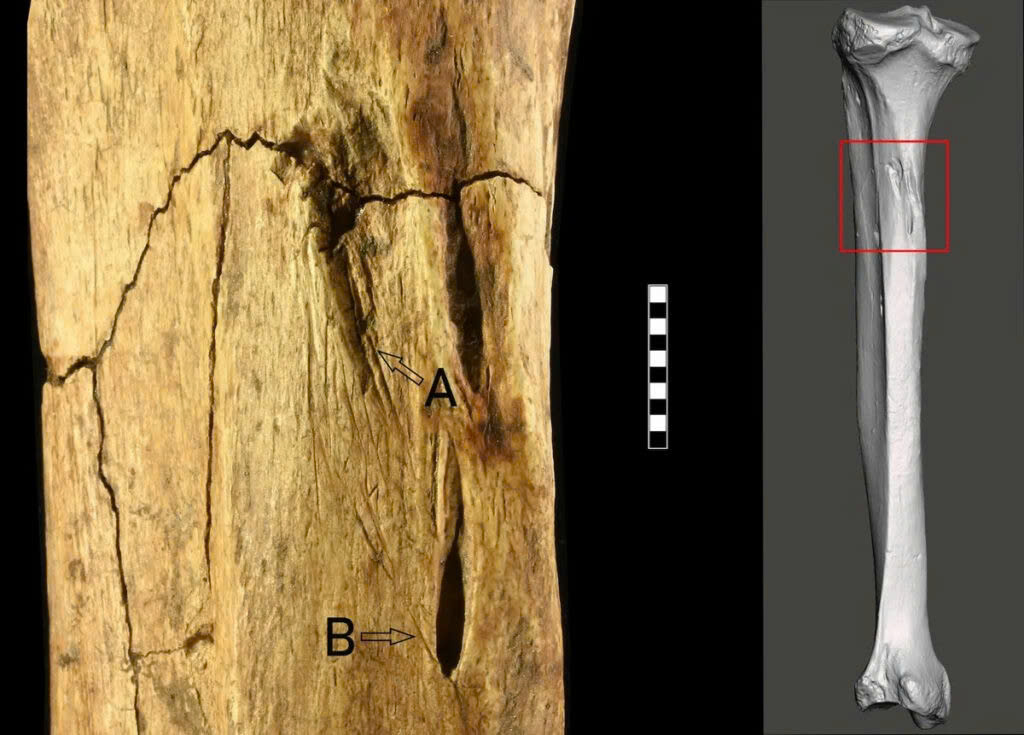A remarkable archaeological discovery in northern Italy has shed new light on prehistoric human interactions, revealing compelling evidence of territorial conflicts dating back nearly 17,000 years. This groundbreaking find offers unprecedented insights into the complex social dynamics of our ancient ancestors.
The Discovery at Riparo Tagliente
Unearthing Ancient Mysteries
In the scenic Lessini Mountains of northeastern Italy, researchers have made a significant breakthrough in understanding prehistoric human behavior. The skeletal remains, known as Tagliente 1, were originally discovered in 1973 at the Riparo Tagliente rock shelter. However, it wasn’t until recent advanced scientific analysis that the true story behind this ancient individual began to emerge.
The remains belong to a young man who lived between 22 and 30 years of age during the Late Epigravettian period, a time when the last Ice Age was ending and new territories were becoming accessible as glaciers retreated.

Revolutionary Scientific Analysis
Modern archaeological techniques have transformed our understanding of this ancient case. Using cutting-edge 3D imaging technology and scanning electron microscopy, researchers led by University of Cagliari bioarchaeologist Vitale Sparacello conducted a comprehensive reanalysis of the skeletal remains.
Uncovering Evidence of Ancient Territorial Disputes
The Forensic Investigation
The scientific team identified five distinct marks on the skeleton’s lower limbs that had previously been misunderstood. These marks, found on the left thigh and lower leg bones, were initially thought to be post-mortem damage or ceremonial markings. However, advanced analysis revealed them to be projectile impact marks caused by high-speed flint-tipped weapons.
The positioning of these marks suggests a complex scenario: wounds on both the front of the thigh and back of the lower leg indicate the individual may have been caught in a coordinated action involving multiple participants. This represents the first time such evidence has been identified purely through skeletal trauma analysis, without physical weapons remaining in the bones.
Understanding Prehistoric Social Dynamics
Archaeological experts believe this incident likely resulted from competition over valuable resources and territory. As the Ice Age ended and new lands became accessible in the Alpine region, different human groups would have encountered each other more frequently, sometimes leading to territorial disputes.
Ethnographic studies of similar small-scale mobile communities suggest that projectile weapons were typically reserved for strategic group actions rather than personal disagreements, indicating this was likely an organized territorial dispute rather than a random encounter.
The Ceremonial Burial: Honor in Death
A Dignified Final Rest
Despite the circumstances of his passing, Tagliente 1 received a respectful burial that speaks to the complex social values of prehistoric communities. The individual was carefully laid to rest in a shallow pit, positioned on his back with arms extended in a deliberate arrangement.
Symbolic Elements and Grave Offerings
The burial included several meaningful elements that suggest deep cultural significance:
- Large stones were placed over the legs, including one featuring carved images of a lion and aurochs horn
- Ochre-stained pebbles were arranged nearby
- A pierced shell was included among the burial items
- The overall arrangement suggests careful planning and community involvement
Cultural Significance of the Burial Practices

The contrast between the circumstances of death and the reverence shown in burial reveals fascinating insights into prehistoric social structures. Scholars suggest several possible interpretations for this dignified treatment:
The burial may have been a way to honor courage and bravery, or it could represent a community’s method of processing and healing from traumatic events. Such ceremonial practices may have served to maintain social cohesion and address the disruption that unexpected deaths could cause in small, tightly-knit groups.
Video
Implications for Understanding Prehistoric Life
A Window into Ancient Society
This discovery provides valuable evidence about the complexity of prehistoric human communities. Rather than simple survival-focused groups, these findings suggest sophisticated social structures, territorial awareness, and elaborate cultural practices surrounding death and remembrance.
Advancing Archaeological Understanding
The successful identification of ancient territorial disputes through skeletal analysis alone represents a significant advancement in archaeological methodology. This approach opens new possibilities for understanding similar cases throughout the archaeological record.
Conclusion: Lessons from the Past
The story of Tagliente 1 offers a unique glimpse into the multifaceted nature of prehistoric life. While territorial disputes were clearly a reality for our ancient ancestors, the ceremonial burial practices demonstrate that these communities also possessed deep cultural values around honor, remembrance, and social healing.
This remarkable discovery continues to provide insights into the complex social dynamics that shaped human development during one of history’s most challenging periods. As archaeological techniques continue to advance, we can expect to uncover even more fascinating details about the lives and cultures of our prehistoric ancestors.
The legacy of Tagliente 1 reminds us that even in humanity’s earliest chapters, our ancestors navigated complex social relationships, territorial challenges, and cultural practices that resonate with human experience across millennia.

